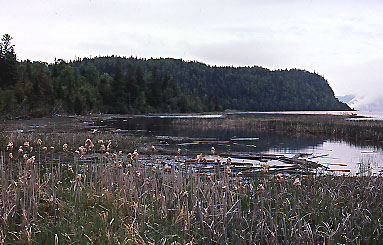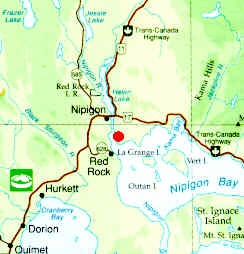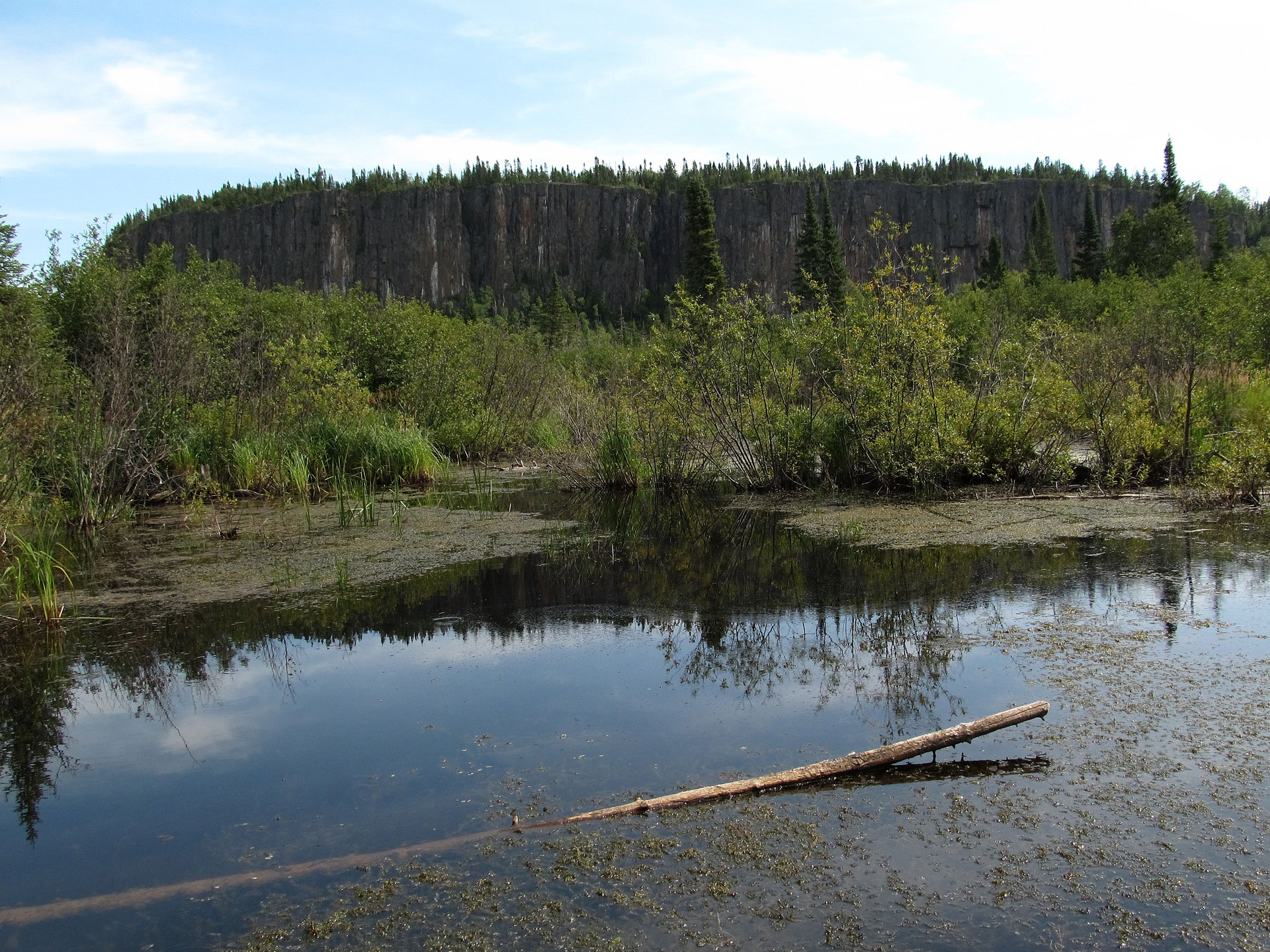Nipigon River Mouth
The Nipigon River Mouth Nature Reserve
Our First Nature Reserve
In the mid 1970’s the Thunder Bay Field Naturalists Club received unexpectedly a lump sum of money through the will of a generous member, Mr. Pallington. The will stipulated that the money was to be spent on acquisition of conservation land. The money enabled the club to start a “Land Acquisition” bank account.
In January of 1994 the Club purchased it’s first nature reserve (red dot on map below). The 320 acre reserve is located on the east side of the Nipigon River south of Nipigon, near where the river enters Lake Superior. The legal description is Lot 8 and Lot 9, Concession 1, Township of Nipigon. The purchase price of the property was $47,452, of which $9,852 came from the Land Acquisition Fund and $37,200 from Ontario Heritage Foundation’s “Natural Heritage Challenge Program”.
Physical Description
The property includes a wetland area along the shore of the Nipigon River, and some high cliffs that rise dramatically straight up from the water. The property is forested with mature second growth mixed forest. The presence of peregrine falcons made protection of this property particularly important. There is no road access to the property.
Nature Reserve Expands in 1999
On December 15, 1999 TBFN purchased two new properties adjacent to the Nipigon River Mouth Nature Reserve. At the November 1999 meeting the membership voted to purchase Con. 1 West Part Lot 10 MR7 Nipigon (37.55 acres) for $10,000 and Con. 1 East part Lot 10 MR6 Nipigon (182 acres) for $13,500. The new properties are strategically positioned adjacent to the original reserve, as well as the new Ruby Lake Provincial Park. The two properties were under threat of development and logging as a private road and cottages were being built on the adjacent part of Lot 10 following a zoning change announced in late September 1999. With these purchases the Nipigon River Mouth Nature Reserve now totals 540 acres.
The newly purchased properties include a variety of habitats: a large wetland area at the Nipigon River mouth, a beaver meadow and several streams, a cedar swamp with hundreds of Yellow Ladyslippers, a high cliff with freestanding rock columns and extensive talus slope, plus many acres of mature forest.
Field Trips to the Nipigon River Mouth Nature Reserve (click to expand)
The Thunder Bay Field Naturalists offer field trips to some of the Nature Reserves every summer. Here is a recap of some of our past excursions to the Nipigon River Mouth Nature Reserve aboard the Morningstar.
June 27th, 1999 19 club members went abroad the Morningstar for a cruise down the Nipigon River starting from the Nipigon Marina. Pictographs were studied on the cliffs on the east shore of the river mouth. Two Bald Eagles were seen on the nest in a huge old poplar on the TBFN reserve. One adult Peregrine Falcon was spotted high on the cliffs at the river mouth. Recent helicopter surveys found three Peregrine chicks in the nest on the cliff this year! An Osprey nest near Cooke Point was spotted. A group of ten American White Pelicans, some in breeding plumage, were seen on an islet in Nipigon Bay. All in all, 46 species of birds were observed.
May 30th, 1998 A group of 22 participants of all ages braved the cold weather and travelled on the Morningstar down the Nipigon River to the Nature Reserve. Two adult Bald Eagles were seen perched on the nest and an Osprey was fishing in the river. About 250 Double-crested Cormorants came diving and flying past the point. One of the young lads on the trip found a skull, later confirmed to be the skull of a lynx! A total of 39 bird species were seen.
Saturday, June 7, 1997 A group of about 25 naturalists headed out on the “Morningstar” for a cruise down the Nipigon River to view the TBFN nature reserve and sights. A total of at least 45 bird species were recorded, including Peregrine Falcon. Waterfowl included Common Loon, Double-crested Cormorant, Canada Goose, Blue-winged Teal, Gadwall, American Widgeon, Common Goldeneye and Common Merganser.
In 1996 two visits were made to the Nature Reserve. Another field trip for the Junior Naturalists was well attended in early June, and a plant collecting expedition took place late in the month. Among new plants found were Striped Coralroot, Flatbranch Juniper and Sweet Cicely.
June 10, 1995 A juniors outing took place with 25 juniors and accompanying adults in attendance. 38 bird species were counted including a Peregrine Falcon. A Bald Eagle’s nest was also sighted and everyone got a good look at the pictographs high up on the cliff face. Some edible wild plants were also sampled.
June 11 and June 27, 1994 A total of 45 people went to take a look at the Nature Reserve on these two boat trips. 56 species of birds were sighted in total.

Shoreline wetlands at the Nipigon River Mouth Nature Reserve. 
Nipigon River Mouth Nature Reserve.

